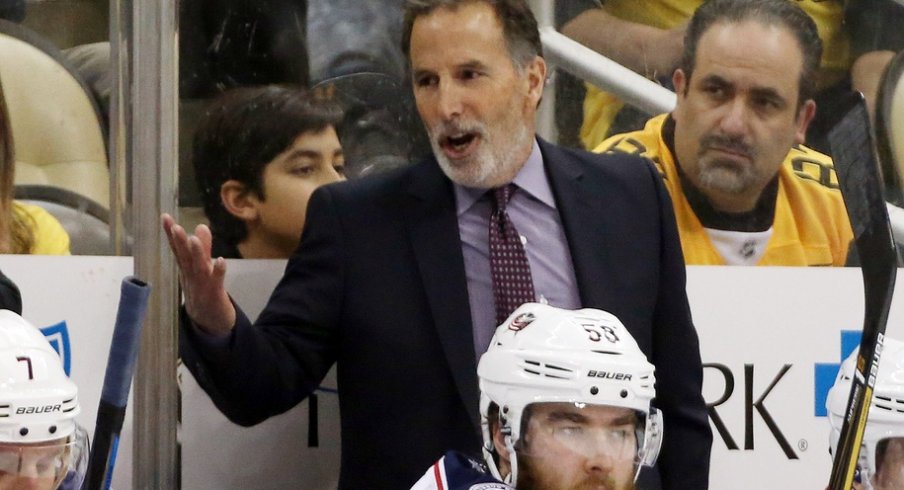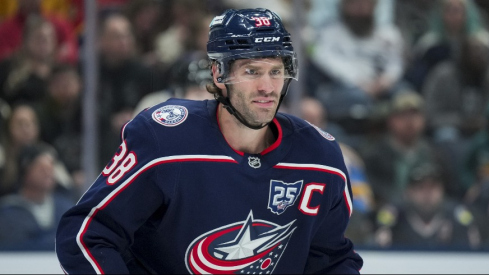Welp, Ryan Lambert is at it again.
That certainly had to be the first thought of many Columbus Blue Jackets fans who checked out Puck Daddy on Wednesday.
The analyst, who made few friends this past season in Ohio’s capital city with his less than bullish thoughts on the CBJ’s progress, gave his thoughts on the one-year contract extension the team gave this week to head coach John Tortorella.
They were not complimentary.
Okay, so let’s say you think John Tortorella is a good coach that will take your team to the next level. You’re objectively wrong about that, but let’s say you think so.
He’s entering the last year of his deal. And you extend him… one year?
That’s weird, right?
I think maybe, and there’s no way to be sure because this is the kind of thing no one would admit, this is basically a bridge contract. “We think you could be good but let’s see what you’ve got when the power play doesn’t shoot 25 percent for two months.”
I mean look, this team is gonna take a step back this season. That’s basically guaranteed. Anyone who thinks the kids collectively improve enough to manufacture enough points to cover a 16-game winning streak and a couple other white-hot runs may want to see a doctor about a potential head injury.
OK. So there’s a lot to unpack there.
Let’s start with this – he does know the Blue Jackets won 50 games last year, right? Let’s actually put that in caps: THE COLUMBUS BLUE JACKETS WON 50 GAMES. This, of course, was history in Columbus, and any coach who put that team on the ice with this franchise, with its history, should be well and deservedly feted.
I mean, Lambert does likely know this. And it’s very tempting to dismiss his analysis as that of an analyst who is sticking to his guns simply for the sake of sticking to his guns. He took a stand against Columbus’ success early last season as largely being a fluke and simply won’t budge.
But here’s a thought.
What if he’s ... right?
I’ll try to explain what I mean by right as much as possible. There’s no doubting Lambert’s contention that Columbus had a lot of things go its way last year, from that likely impossible-to-duplicate 16-game win streak to a blazing hot power play that stole a few wins in the first half of the season to a general feeling of momentum the likes of which the franchise had never seen before.
And he’s also probably right that it will be difficult to repeat and build on last season’s success. I’m even not referring to complacency, which I don’t expect will really affect this roster in a large way, or personnel, despite the loss of forwards Brandon Saad, Sam Gagner, Scott Hartnell and William Karlsson.
But in sports, it’s often hard for a team that makes a large jump one year to continue it the next. It’s the baseball writer Bill James’ Plexiglass Principle: Teams that significantly improve in one season tend to decline in the following year, and vice versa. It just happens.
So starting there, let’s talk about Tortorella a bit. I’m not really going to take seriously the contention he’s a bad coach, not someone who has a Stanley Cup ring and also was the first American coach to win 500 games.
Criticisms of Tortorella tend to range from his outbursts at the media (overplayed), his disastrous tenure in Vancouver (disastrous indeed) and his piloting of last year’s World Cup squad (irrelevant), but you pretty much have to admit he’s pushed a lot of the right buttons in his “safe or death” era in Columbus.
But let’s also acknowledge his tenure hasn’t exactly been marked by adversity in Columbus. He took over an 0-7 team whose playoff hopes were all but over in 2015. No one would say it publicly at the time, but that season was more about building for the future than trying to win. It wasn’t tremendously easy – just ask Nick Foligno – but things were worked on away from the white-hot glare of a playoff race or the microscope of high expectations.
Then came last year’s charmed season, in which everything the team touched turned to gold for five months. So what happens if the natural regression comes or the team gets off to a rough start, the expectations grow heavier, and Columbus is sitting below .500 going into December? How does the team react? How does Tortorella react? How does the team react to how Tortorella reacts? How does Tortorella react to that reaction?
Not to get too deep into it, but those are questions that just haven’t had to be faced yet in Columbus. I’m not saying predicting disaster. I’m not saying that if the team does hit a rough patch, the coach or the team will react negatively. Heck, there might not even be a rough patch. I’m just saying it would be a new world for this particular group of people, and it’s impossible to know what might happen from there.
So what’s my point here? (That’s a good question.) Generally, it is true that regression seems likely, as Lambert suggests. How much regression will determine whether Columbus will again be a playoff team in what again should be one of the league's toughest divisions.
But here's something I will say: After last season, there aren’t many people I’d rather have coaching the Blue Jackets at this moment than John Tortorella. And right now, that's good enough for me.
Alternate World
I noticed this a few weeks ago when I broke down Columbus’ all-time first-round picks, but something my colleague Dan Dukart wrote yesterday again made it pop into my mind.
His breakdown of the Marian Gaborik trade reminded me about how the Jackets twice in a two-year span traded first-round picks who had showed signs of becoming quite good NHL players. Those deals were each reasonable ideas, but each essentially blew up in the team’s face.
That Gaborik trade in April 2013 sent center Derick Brassard to New York along with Derek Dorsett and John Moore. Brassard, the team’s 2006 first-round pick, went on to post a 69-105-174 line in 254 games with the Rangers before moving to Ottawa. Gaborik, meanwhile, had nine goals in just 34 games in Columbus before being dealt to Los Angeles for Matt Frattin and draft picks.
A similar trade occurred in the summer of 2011 when the team sent 2007 first-round pick Jake Voracek to Philadelphia in the Jeff Carter trade. Carter, of course, lasted only 39 games in Columbus – scoring 15 goals – before sulking his way to LA, where he again became one of the top goal scorers in the NHL. That deal netted Jack Johnson, but it seems likely the team wishes it still had Voracek, who has averaged 21 goals and 66 points per 82 games and made a pair of All-Star appearances in Philly.
Where would the franchise be if it had just kept Brassard and Voracek? That, of course, is impossible to answer, but while each of those deals was an understandable gamble at the time, each came up snake eyes. And each played into the narrative that Columbus has wasted many of its first-round picks over the years, one that isn’t quite as true as it seems on first glance simply because many of those players were dealt before going on to have solid NHL careers.
Eye of the Beholder
One cool thing about the Twittersphere is there are some smart cookies out there. It’s not hard to find interesting things that make you think if you follow the right people.
Here’s one of those things.
Player 1 is Matt Duchene and the terrible awful no good 2016/17 season
— Jeremy Crowe (@307x) August 1, 2017
Player 2 is multiple NHL award winner Nick Foligno https://t.co/o4jKvdmeKX
Well, how about that. There is certainly a narrative out there that Duchene must rebound from an off year, while Foligno reignited his NHL career after a disastrous 2015-16. And it’s hard to draw up two similar players, production wise, when looking at those numbers.
Of course, that sells the narrative a bit short. Duchene had 70 points in 71 games in 2013-14 and is generally viewed as the more explosive offensive player, so more is expected even in a year when he was dragged down by being on the worst team in the NHL.
Foligno, meanwhile, has had a more interesting NHL career, going from a grinder who had never topped 50 points in his first seven seasons to a stunning 31-42-73 season in 2014-15. Then came his disappointing 12-25-37 year in his first season as a captain before last year’s bounce-back 26-25-51 mark.
In other words, they’re not the same style player, but somehow they got to the same place last year. And hey, it makes you think, doesn’t it?

